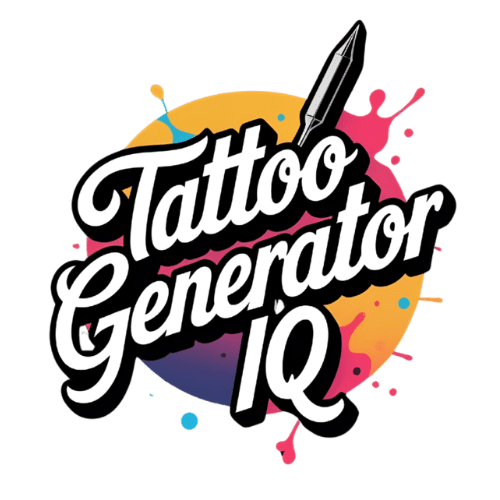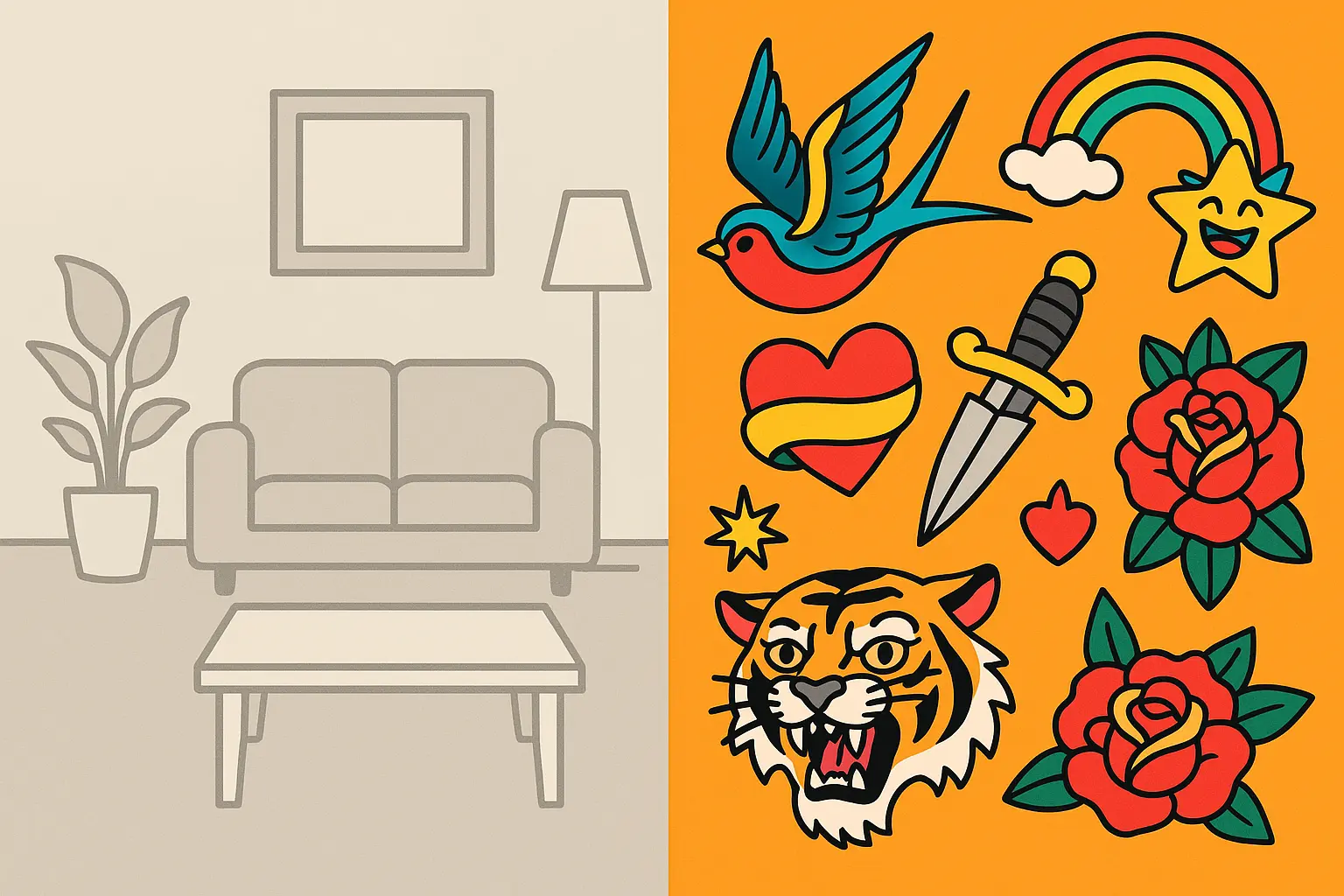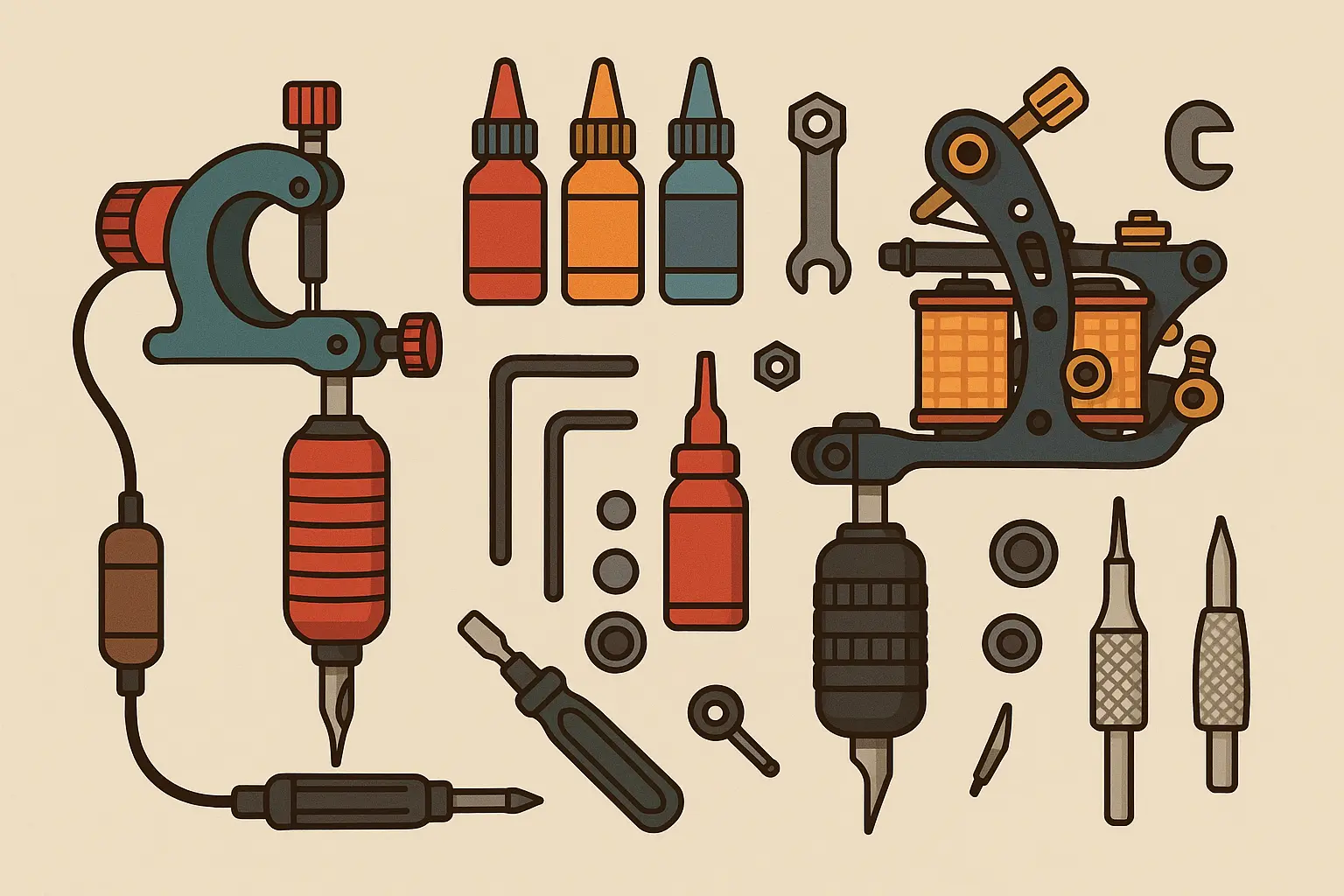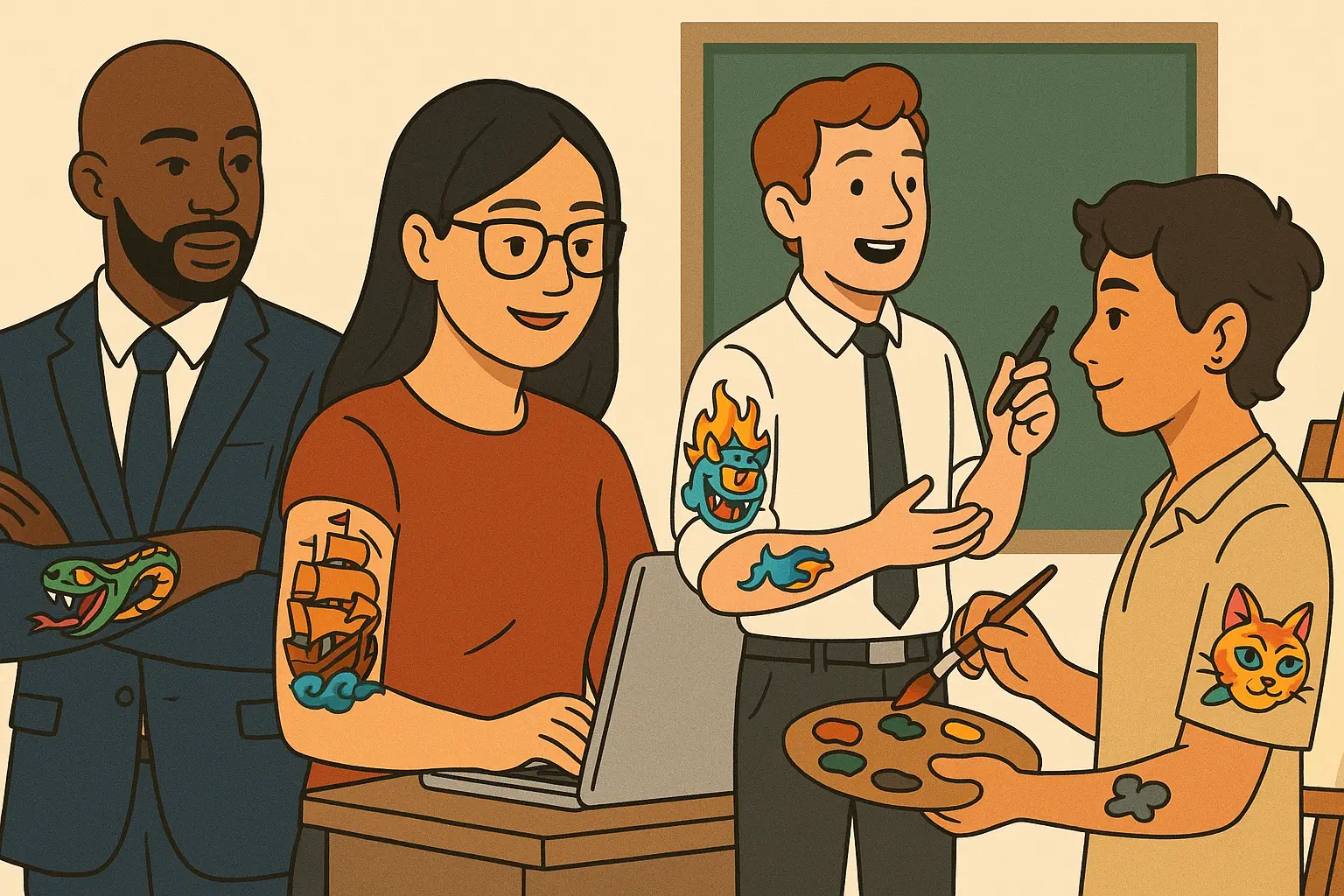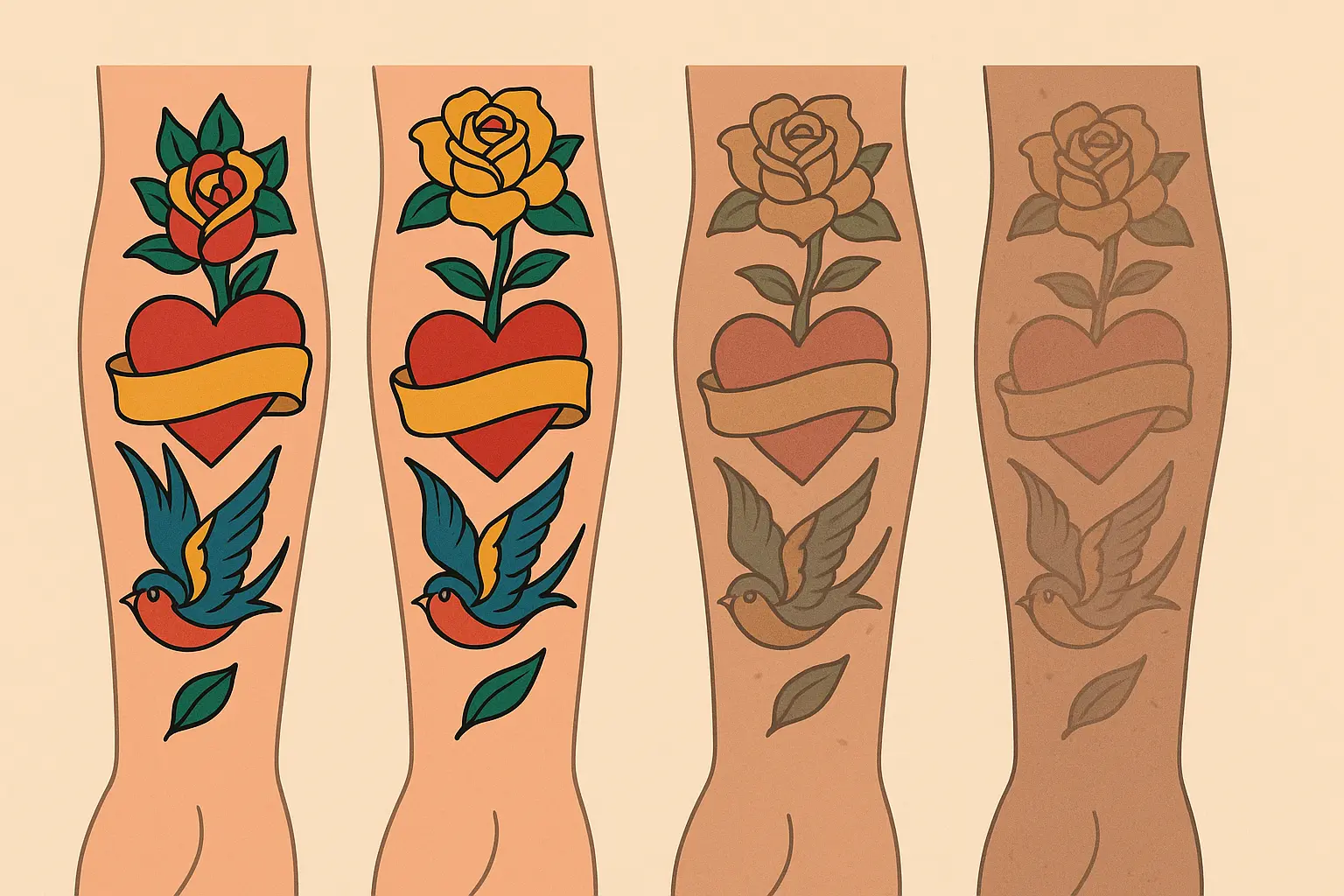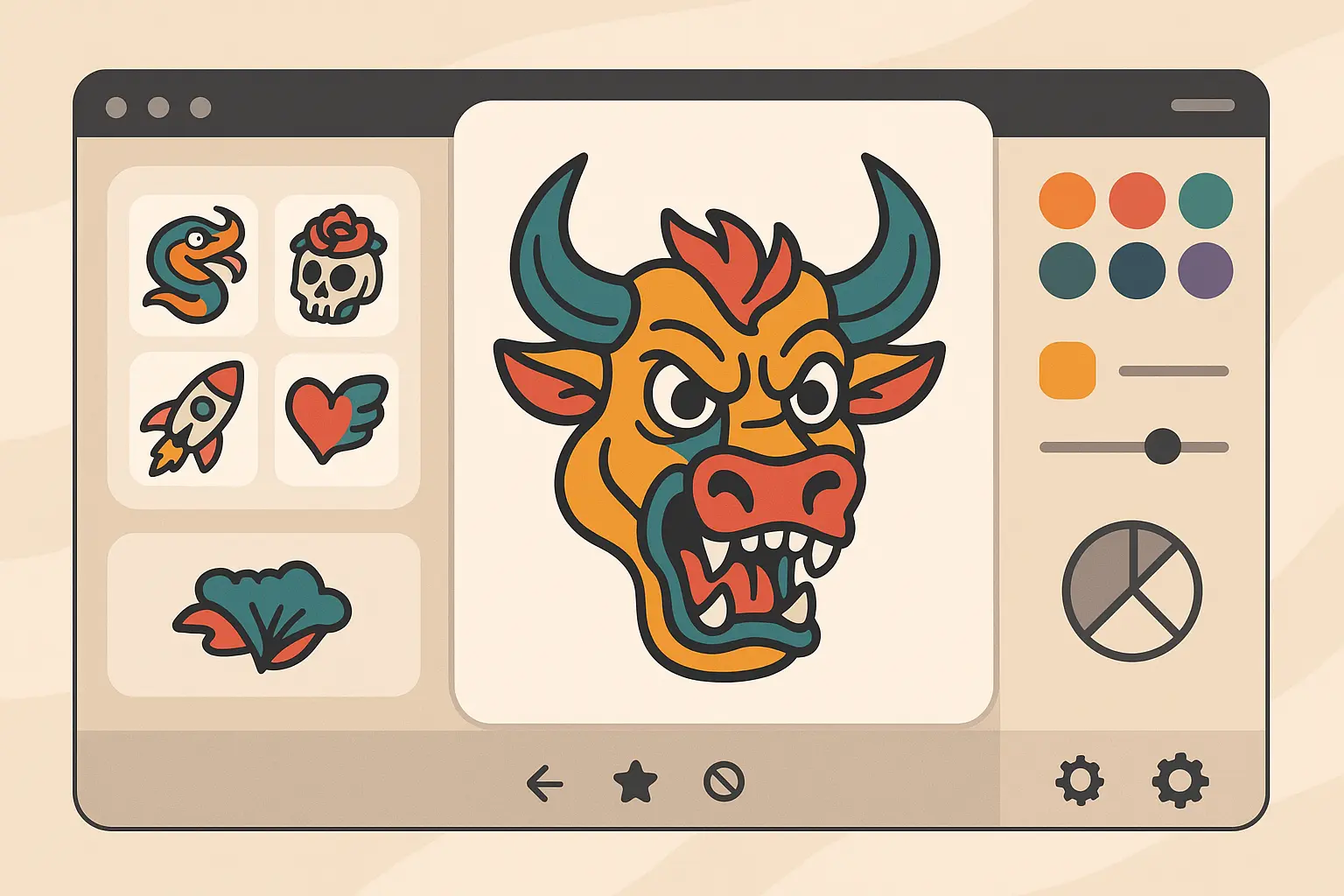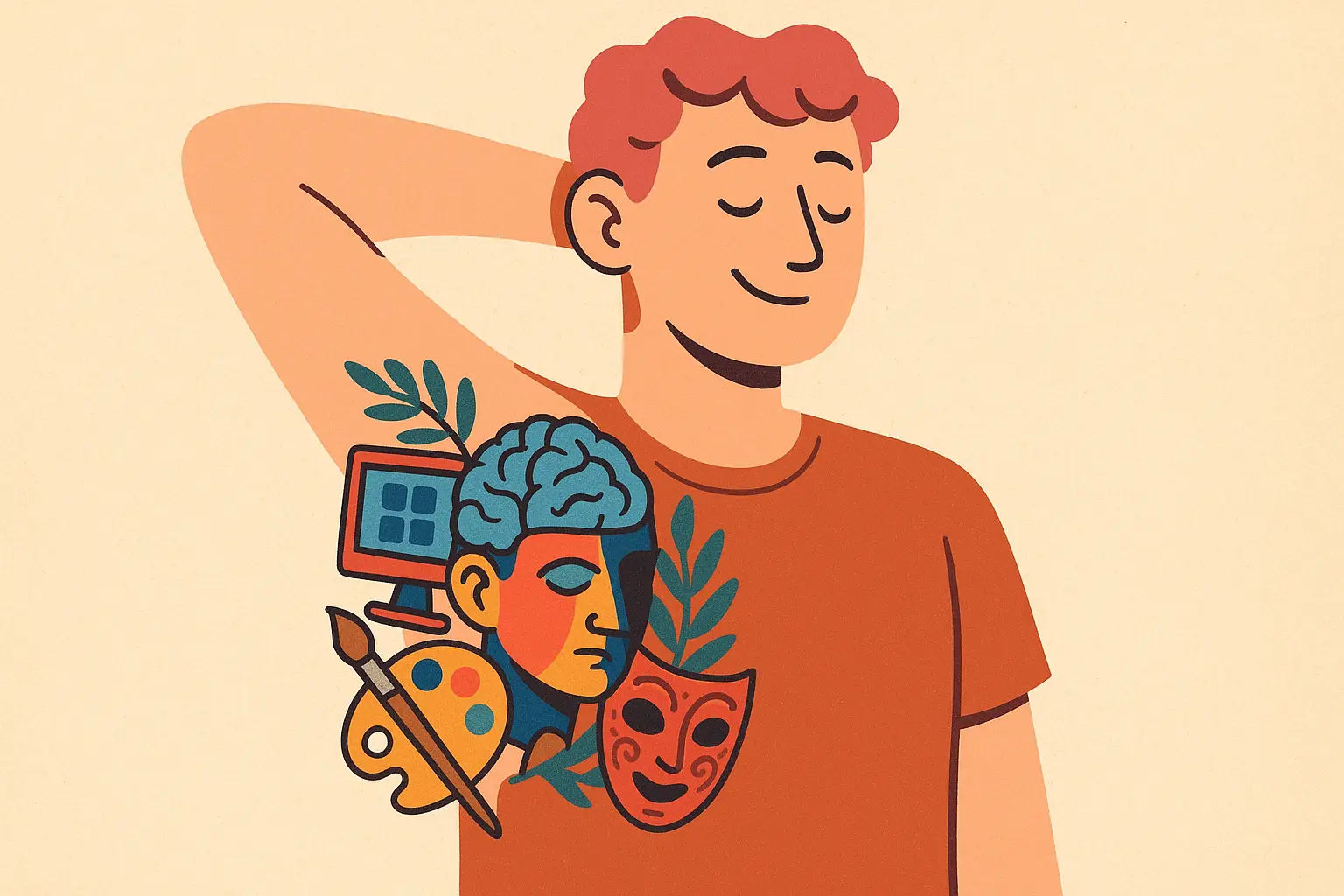New School Tattoo Style: Why These Vibrant Designs Hit Different (And It’s Not Just the Colors)
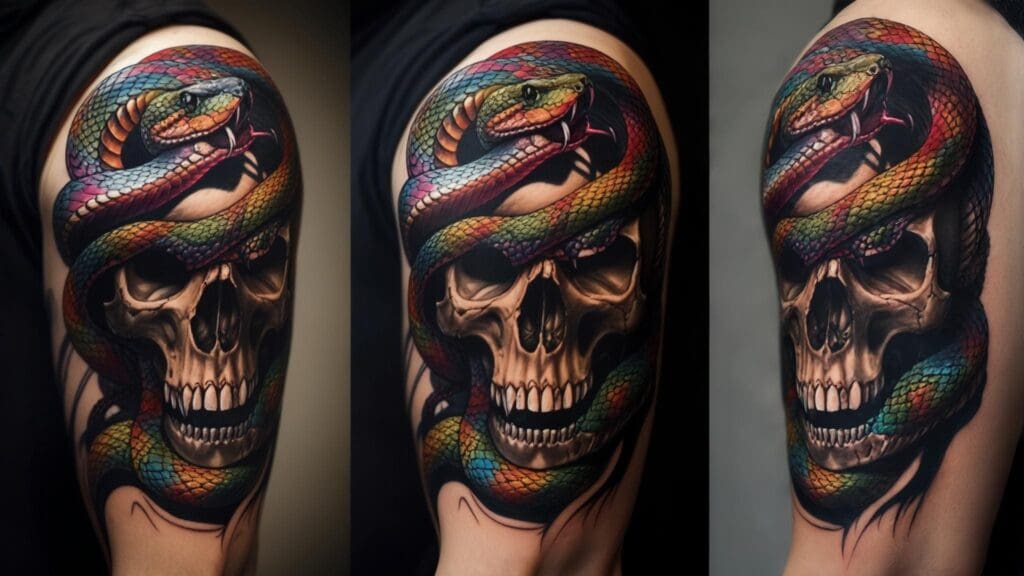
Table of Contents
-
Why New School Tattoos Mess with Your Brain in the Best Way
-
The Seriously Cool Techniques That Make New School Pop
-
Cultural Identity Hidden in Plain Sight
-
How Color and Design Can Actually Help Your Mental Health
-
The Unspoken Code of Subcultural Communication
-
Future Tech That Might Actually Happen
-
Final Thoughts
TL;DR
-
New school tattoos trigger specific brain responses through super-saturated colors and cartoon proportions that create genuinely addictive visual experiences
-
The style uses totally different color techniques requiring 3-4 times more needle passes than traditional work
-
These tattoos work as personal cultural archives, documenting your generational experiences through pop culture references
-
Some artists are creating “prescriptive” tattoos using color psychology to support mental health treatment
-
New school operates as a complete visual language with grammar rules for subcultural communication
-
The style’s digital foundation makes it perfect for future AR integration and smart ink technologies
The explosion of new school tattoos reflects something bigger happening culturally. Oregon alone saw a 77% increase in tattoo licenses from 2019 to 2024 according to Oregon Public Broadcasting, showing how this vibrant style has contributed to an unprecedented boom in tattoo artistry nationwide.
Why New School Tattoos Mess with Your Brain in the Best Way
Look, I’ve been watching people react to new school tattoos for years, and there’s definitely something deeper going on than just “wow, pretty colors.” The vibrant colors and cartoon-meets-reality combinations actually trigger specific responses in your brain while creating what psychologists call “productive cognitive dissonance” – basically, your brain gets confused in a good way.
I’ve seen people stop mid-conversation when they spot a good new school piece. There’s something happening neurologically that goes way beyond traditional black-and-gray work.
Your Brain on New School: The Dopamine Connection
How Those Electric Colors Actually Rewire Your Brain
Ever wonder why new school tattoos seem to jump off the skin? Those electric blues, hot pinks, and lime greens don’t just look cool – they activate multiple neural pathways simultaneously through something scientists call chromatic neuroplasticity. Basically, those crazy colors actually create new connections in your brain. Wild, right?
This creates experiences that hit multiple senses at once and form lasting memory imprints that make new school tattoos feel more “alive” than traditional work. Your brain literally can’t process these colors the same way it handles regular black-and-gray pieces.
Here’s the thing – traditional tattoos simply can’t activate these same pathways. Those vibrant new school pieces actually rewire how your brain processes visual information, which explains why they often feel more emotionally significant than they probably should.
The Cartoon-Reality Mind Trick That Actually Works
New school artists deliberately mess with your head by combining cartoon proportions with hyperrealistic shading. Your brain tries to process familiar cartoon logic (those oversized eyes, exaggerated expressions) while simultaneously recognizing photorealistic rendering techniques.
Instead of being confusing, this mental tension forces your brain to pay more attention. You can’t quite categorize what you’re looking at, so your mind works harder to process it. That extra effort makes the tattoo more memorable and emotionally significant.
Understanding these brain responses becomes crucial when exploring color tattoo designs that leverage similar neurological tricks to create lasting visual impact.
Why Bigger Really Does Hit Harder Emotionally
Those massive roses and giant cartoon eyes aren’t just stylistic choices – they’re emotional amplification devices. When artists deliberately distort proportions, they’re triggering your brain’s response to what researchers call “supernormal stimuli” – basically, features that are bigger and bolder than real life.
A rose with petals three times normal size doesn’t just look bigger – it creates a stronger emotional reaction than realistic proportions would generate. Your brain is hardwired to respond more intensely to exaggerated features, which is why new school’s oversized elements feel so emotionally charged.
Digital Native Design Philosophy
Instagram-Ready Composition (Whether Artists Admit It or Not)
Here’s something most people don’t realize – new school tattoos will be seen more often on screens than in person. Smart artists have figured this out, even if they don’t consciously think about it. The style’s emphasis on bold outlines, high contrast, and saturated colors isn’t just aesthetic preference – it’s optimization for digital compression.
These design choices ensure your tattoo remains visually impactful even when it’s reduced to a tiny thumbnail on Instagram. Traditional tattoos often lose their impact when compressed for social media, but new school pieces are built to thrive in digital spaces.
Think about the last time you scrolled past a tattoo on Instagram that made you stop and zoom in – probably new school. Consider a Pokemon tattoo featuring Pikachu with electric blue lightning bolts and hot pink cheeks. The bold yellow body with thick black outlines reads perfectly on Instagram, while the exaggerated proportions and vibrant colors trigger immediate emotional recognition. When compressed to thumbnail size, the high contrast elements remain clearly visible, unlike a traditional piece that might become muddy and indistinct.
Personal Memes and Cultural Broadcasting
New school tattoos frequently function as personal memes – visual shorthand that communicates complex cultural identities. That Pokemon piece isn’t just nostalgia; it’s a sophisticated cultural signal about gaming identity, generational belonging, and ironic appreciation of childhood symbols.
The style’s cartoon influences and pop culture references create tattoos that speak fluent internet. You’re essentially wearing your cultural DNA, broadcasting your digital native status through visual elements that older generations might not fully understand.
Fighting Back Against Sterile Minimalism
Maximalism as Mental Health Medicine
We’re surrounded by sterile minimalism everywhere – from our phones to our offices to our apartments. Research in environmental psychology shows this visual emptiness can actually contribute to depression and cognitive decline. Visually complex, colorful environments improve mood and brain function.
New school tattoos create portable environments of visual richness. When you’re wearing a vibrant new school sleeve, you’re carrying constant visual stimulation that can positively impact your mental health. Think of them as personal antidotes to the stark minimalism of modern life, permanently attached to your body.
The maximalist approach isn’t just aesthetic rebellion – it’s a mental health strategy. Your brain craves visual complexity and emotional richness, and new school delivers both.
The Seriously Cool Techniques That Make New School Pop
New school represents a fundamental technical evolution in tattooing that challenges century-old industry standards. Artists have developed totally different color layering methods, modified equipment setups, and unconventional healing protocols to achieve unprecedented vibrancy and effects that traditional techniques simply cannot produce.
Color Saturation Secrets That Actually Work
The Multi-Pass Color Building Game-Changer
Forget everything you think you know about tattoo coloring. New school artists have completely flipped how color gets into skin, and it’s way more complex than traditional tattooing.
Here’s something most people don’t realize – those crazy bright colors aren’t just regular tattoo ink cranked up to 11. The signature vibrancy comes from multi-pass color building techniques that layer transparent and opaque pigments in specific sequences. We’re talking about 3-4 times more needle passes than traditional work, but the results are impossible to achieve any other way.
Here’s the basic process: Start with base color washes using diluted pigments and larger needle groupings. Build mid-tones with standard opacity pigments and medium needles. Add shadows using complementary color theory. Layer highlights with specialized light pigments and fine needles. Finish with final saturation boosts using concentrated pigment formulations.
Each step requires different needle configurations and machine settings. It’s like building a painting in layers, except you’re doing it permanently in someone’s skin.
This technical complexity mirrors the precision required for fine line tattoo ideas, where multiple passes and specialized techniques create intricate detail work that demands similar technical mastery.
|
Color Building Phase |
Needle Configuration |
Pigment Type |
Machine Setting |
Purpose |
|---|---|---|---|---|
|
Base Wash |
9-15 Round Liner |
Diluted Transparent |
Low Voltage |
Color Foundation |
|
Mid-Tone Build |
7-9 Round Shader |
Standard Opacity |
Medium Voltage |
Color Depth |
|
Shadow Integration |
5-7 Round Shader |
Complementary Colors |
Medium-High Voltage |
Dimensional Contrast |
|
Highlight Pass |
3-5 Round Liner |
Specialized Light Pigments |
High Voltage |
Luminosity |
|
Saturation Boost |
7-9 Round Shader |
Concentrated Pigments |
Medium Voltage |
Final Vibrancy |
Custom Pigment Chemistry (Artists Are Becoming Mad Scientists)
Standard tattoo pigments can’t achieve the electric colors new school demands. Artists have become amateur chemists, developing personal color recipes that often incorporate pigments from automotive or cosmetic industries.
These custom mixes offer superior vibrancy but come with challenges. Different pigments heal differently, fade at different rates, and require modified application techniques. Some artists guard their color recipes because they’ve spent years perfecting formulations that create specific effects.
The experimentation extends to mixing ratios, dilution techniques, and even combining pigments that technically shouldn’t work together. It’s part art, part science, and completely different compared to traditional tattooing approaches.
Machine Modifications That Change Everything
The Hybrid Equipment Approach
Traditional tattoo artists typically stick with one machine type, but new school demands have blown that approach apart. The technical requirements are so diverse that many artists run hybrid setups – rotary machines modified with custom cam wheels for smooth color saturation, then coil machines with modified spring tensions for sharp, varied line weights.
This hybrid approach requires deep technical knowledge. You need to understand how different machines affect pigment deposition, how to modify equipment without compromising safety, and how to switch between machines while maintaining sterile technique.
The equipment modifications get pretty intense: custom needle depth settings for specific color effects, modified spring tensions for variable line weights, custom needle groupings for particular techniques. Some artists essentially rebuild their machines to achieve effects that stock equipment simply can’t produce.
It’s like being a tattoo artist and a mechanical engineer at the same time. The technical barrier to entry is way higher than traditional tattooing, but the results justify the complexity.
This technical complexity is reflected in educational programs emerging nationwide. “DeWitt Clinton High School in New York recently launched a tattoo program where students learn neo-traditional and new-school styles” according to Riverdale Press, with instructor Carlos Ramirez noting that “new-school tattoo keeps similar elements of heavy black outlines and colors but often depicts cartoons or media figures in an exaggerated way.”
Cultural Identity Hidden in Plain Sight
New school functions as a sophisticated cultural language system that allows individuals to communicate generational identity, subcultural belonging, and personal narrative through visual codes. These tattoos operate as personal museums of pop culture artifacts while enabling code-switching between different cultural contexts.
Generational Time Capsules on Skin
Pop Culture Archaeology in Ink
Your new school tattoo is basically a personal museum. These pieces often combine 90s cartoon characters with contemporary gaming references and retro aesthetic elements, creating layered cultural archaeology that documents your entire cultural journey.
The significance is huge. Traditional tattoos reference timeless symbols, but new school work captures specific cultural moments. That piece combining Pokemon with current meme aesthetics isn’t just decoration – it’s documenting exactly when and how you encountered these cultural influences.
Each element serves as a time capsule. The cartoon style references your childhood media consumption. The color palette reflects current digital aesthetics. The composition techniques show contemporary artistic influences. Your body becomes a living archive of generational experience.
Future anthropologists could probably reconstruct entire cultural movements just by studying new school tattoos from this era. We’re essentially wearing our cultural DNA.
This archaeological approach to body art reflects broader trends in anime tattoos where cultural references span decades of media evolution and personal identity formation.
A typical new school sleeve might feature a 90s cartoon character wearing modern streetwear, surrounded by contemporary gaming icons, all rendered in current digital art aesthetics with neon gradients and glitch effects. This single piece documents three decades of cultural evolution: 90s animation nostalgia, current gaming culture, and modern digital art trends.
Subcultural Code-Switching Tools
New school excels at subcultural code-switching – communicating membership in specific communities while remaining professionally acceptable. A sophisticated video game character can signal gaming culture membership to insiders while appearing as abstract art to outsiders.
This dual-functionality is crucial for navigating modern identity requirements. You need to signal authenticity to your communities while maintaining professional credibility. New school’s artistic sophistication provides plausible deniability – it’s “just art” to those who don’t understand the cultural references.
The strategic placement becomes part of the communication strategy. Visible pieces use more universal artistic elements, while hidden tattoos can be more explicitly subcultural. You’re essentially wearing different cultural uniforms for different social contexts.
The Economics of Artistic Innovation
Skill Premium and Market Differentiation
New school’s technical complexity creates serious economic advantages. The multi-pass color techniques, custom pigment mixing, and equipment modifications represent major skill investments that justify premium pricing.
This economic dynamic encourages continued innovation. Artists seek competitive advantages through technical advancement, pushing the style’s boundaries further. The skill barrier to entry is high enough that mastering new school techniques becomes a legitimate market differentiator.
For artists transitioning to new school, the investment is substantial: advanced color theory education, custom pigment mixing capabilities, multiple machine mastery, portfolio development, and premium pricing structure establishment. But the economic returns justify the investment.
The style has essentially created a new tier of tattoo artistry that transcends traditional shop hierarchies.
Cultural Capital Investment
New school’s crossover appeal with fine art, illustration, and digital art communities creates cultural capital that traditional tattoo styles can’t match. Owning work by recognized new school artists carries social prestige similar to collecting contemporary art.
Certain pieces appreciate in cultural value over time. The artist’s reputation, the piece’s innovation, and its cultural significance all contribute to its social worth. You’re making a cultural capital investment.
This dynamic has changed how people approach tattoo collecting. Instead of just getting work from local shops, collectors seek out specific artists whose work carries cultural prestige. The tattoo becomes a status symbol that operates in multiple cultural contexts.
How Color and Design Can Actually Help Your Mental Health
New school tattoo style has pioneered therapeutic applications that extend beyond traditional tattoo therapy, using specific color combinations and design elements to address psychological conditions. Some artists increasingly work with mental health professionals to create “prescriptive” tattoos that support treatment for anxiety, depression, and PTSD while serving as mindfulness anchoring tools.
Color Psychology That Might Actually Work
When Artists Become Amateur Therapists
New school’s color palette naturally aligns with color therapy research, and some artists are taking this connection seriously. Specific blue-green combinations can reduce anxiety responses, while certain warm color progressions might help combat depressive episodes.
Artists working in therapeutic contexts learn to balance aesthetic appeal with color psychology research. They’re creating tattoos that function as wearable mood regulation tools – pieces that look amazing but also provide psychological benefits through their color choices.
Look, I know this sounds like I’m overselling it, but the science is solid. Different colors trigger different neurological responses. Blue wavelengths activate nervous system responses that reduce stress. Warm oranges and yellows stimulate serotonin production. Artists can literally prescribe color combinations based on what psychological effects their clients need.
This therapeutic approach aligns with broader applications found in depression tattoo ideas where visual elements serve as powerful tools for mental health support and emotional processing.
|
Color Combination |
Psychological Effect |
Neurological Response |
Therapeutic Application |
|---|---|---|---|
|
Deep Blue + Teal |
Anxiety Reduction |
Parasympathetic Activation |
Panic Disorder Support |
|
Warm Orange + Yellow |
Mood Elevation |
Serotonin Stimulation |
Depression Management |
|
Purple + Magenta |
Creativity Enhancement |
Right Brain Activation |
ADHD Focus Support |
|
Green + Earth Tones |
Stress Relief |
Cortisol Reduction |
PTSD Grounding |
|
Red + Pink Gradients |
Energy Boost |
Dopamine Release |
Motivation Enhancement |
Trauma Processing Through Safe Symbolism
The style’s ability to blend realistic elements with cartoon safety creates unique opportunities for trauma processing. Survivors can represent difficult experiences in ways that feel manageable – the cartoon elements provide emotional distance while the realistic rendering maintains symbolic power.
A phoenix emerging from stylized flames can represent overcoming abuse without triggering traumatic memories. The cartoon-style flames feel safe, but the realistic phoenix carries the full symbolic weight of transformation and survival. Therapeutic representation that doesn’t retraumatize.
Mental health professionals are starting to understand how new school’s visual language can support therapy. The style offers ways to externalize internal experiences that feel both authentic and emotionally manageable.
Mindfulness Anchoring Through Visual Design
Breathing Pattern Integration
New school’s flowing lines and color transitions can be designed to mirror optimal breathing rhythms. A sleeve might feature wave patterns or color gradations that naturally guide your eye in rhythms matching meditative breathing.
This isn’t accidental – it’s intentional therapeutic design. When you’re stressed, your eyes naturally follow these visual patterns, which unconsciously guides your breathing toward calmer states. Your tattoo becomes a built-in stress management tool.
The placement strategy matters too. Pieces positioned where you’ll naturally see them during stressful moments (forearm areas) can provide immediate mindfulness anchoring. You’re essentially wearing meditation aids that activate automatically when you need them most.
The Unspoken Code of Subcultural Communication
New school operates as a complete visual language with sophisticated grammar rules governing how elements combine to create specific meanings. The style uses layered meanings where surface elements convey one message to general audiences while hidden elements communicate different messages to subcultural insiders, creating complex cultural communication tools.
Visual Grammar Systems That Actually Work
How Artists Hide Meanings Within Meanings
New school artists develop sophisticated visual vocabularies where element combinations create specific meanings. A gaming-themed piece might use color combinations that reference specific game mechanics, character relationships, or community in-jokes that are completely invisible to outsiders but immediately recognizable to community members.
The layering gets incredibly complex. Surface level: cool cartoon character. Second level: specific game reference. Third level: commentary on game mechanics. Fourth level: inside joke about community drama. Each layer communicates to different audience segments while maintaining overall aesthetic appeal.
I watched a guy explain his new school Mario tattoo to his grandmother – she thought it was “just a cute cartoon” while his gaming friends immediately spotted the reference to a specific speedrun technique. Same tattoo, completely different meanings.
The process involves identifying your target audience’s knowledge base, developing primary visual narratives for general consumption, embedding secondary meanings through color and detail choices, testing design recognition with community members, and refining elements to optimize dual-meaning functionality.
A new school tattoo featuring a cute cartoon cat might appear as simple anime-inspired art to most viewers. But to gamers, the cat’s specific pose references a popular Twitch emote, its color scheme matches a legendary item from a specific MMO, and small details in the background reference inside jokes from streaming culture. Each layer communicates to progressively smaller, more specialized audiences while maintaining broad aesthetic appeal.
This multi-layered approach to design creation benefits from tools such as AI tattoo generators that can help visualize complex symbolic relationships and cultural references within cohesive artistic compositions.
Subcultural Code Evolution
New school’s connection to rapidly evolving digital culture means its visual codes change constantly. Memes die, new games launch, streaming communities shift, and the visual language has to evolve to stay relevant.
Artists must stay current with gaming culture evolution, meme lifecycle patterns, streaming community dynamics, and emerging digital subcultures. What was culturally relevant six months ago might be completely dead now. The visual codes have to evolve to maintain authenticity.
This creates interesting challenges for permanent body art. How do you create something that will remain culturally relevant as digital culture shifts? Smart artists focus on foundational cultural elements rather than specific trending references.
Cross-Cultural Translation Challenges
When Pop Culture References Don’t Translate
New school’s pop culture references often carry Western cultural assumptions that don’t translate globally. An artist working with international clients must understand how cartoon styles, gaming references, or internet culture elements might be perceived in different cultural contexts.
What reads as nostalgic and playful in American culture might be interpreted as childish or inappropriate in other contexts. Gaming references that signal sophisticated cultural knowledge in one community might be completely meaningless in another.
This requires cultural sensitivity that goes way beyond traditional tattoo considerations. Artists need to understand not just what images mean, but how those meanings shift across cultural boundaries. Sometimes designs need significant modification for cultural appropriateness.
The challenge is maintaining the style’s essential character while adapting its cultural references for different contexts. It’s possible, but it requires deep cultural understanding and careful adaptation.
Future Tech That Might Actually Happen
New school style is uniquely positioned to integrate emerging technologies due to its digital-native foundation. The style’s compatibility with augmented reality integration, QR code embedding, and smart ink technologies opens possibilities for tattoos that exist simultaneously in physical and digital spaces while evolving over time.
Augmented Reality Integration Potential
QR Integration and Digital Extensions
New school’s bold graphic elements and high contrast design principles make it uniquely compatible with QR code integration and AR triggers. Artists can embed functional digital elements within aesthetic designs, creating tattoos that unlock digital content, connect to social media, or trigger augmented reality experiences when viewed through smartphones.
Look, some of this AR and smart ink stuff might sound like sci-fi, but we’re already seeing QR codes worked into tattoo designs. It’s not that crazy to think your tattoo might do more than just look cool in a few years.
This technological integration transforms tattoos from static art into interactive media. Your piece could unlock exclusive content, connect to your social profiles, or trigger AR experiences that change over time. The tattoo becomes a portal between physical and digital spaces.
The possibilities are genuinely surprising: tattoos that display different AR overlays based on who’s viewing them, pieces that unlock new content as you achieve life milestones, or designs that connect to live data feeds and display real-time information through AR interfaces.
This technological integration comes at a time when the tattoo industry is experiencing unprecedented growth. Recent data shows that “Oregon saw a 77% increase in the number of tattoo licenses from 2019 to 2024” according to Oregon Public Broadcasting, with many new artists specifically drawn to innovative styles that embrace technological possibilities.
Smart Ink Compatibility
New school’s technical innovation culture makes it the natural testing ground for smart ink technologies. The style’s acceptance of unconventional pigments and experimental techniques creates an environment where color-changing, temperature-responsive, or biometric-monitoring inks can be integrated aesthetically rather than appearing purely functional.
Imagine tattoos that change color based on your mood, body temperature, or stress levels. Or pieces that can display basic biometric information through color shifts. The new school aesthetic could incorporate these technologies seamlessly because the style already embraces bold color changes and technical innovation.
The integration possibilities extend to tattoos that respond to environmental conditions, connect to your fitness tracker, or even display notifications through subtle color changes. Your body art becomes part of your personal technology ecosystem.
Bio-Responsive Design Philosophy
Aging-Adaptive Composition
New school’s technical sophistication extends to understanding how skin changes over time. Artists study how different skin areas age and stretch, then design compositions that will remain aesthetically pleasing as your body changes over decades.
Fine details get placed in stable skin areas such as the upper back, while bold, graphic elements occupy areas that experience more movement and stretching. The design anticipates how aging will affect different elements and plans accordingly.
This involves mapping your skin elasticity patterns and lifestyle factors, identifying high-stability zones for detailed elements, designing bold backup elements for areas prone to distortion, planning color fade patterns that enhance rather than detract from aging, and creating maintenance protocols for long-term vibrancy.
It’s tattoo design that thinks 20-30 years into the future, ensuring your piece will look intentional and beautiful even as your body changes.
The sophistication of modern tattoo education reflects this forward-thinking approach. “Students at DeWitt Clinton High School are learning artistic techniques and also safety protocols and business entrepreneurship” according to Riverdale Press, with instructor Carlos Ramirez emphasizing that “the exam is mostly safety and protocols” while teaching students to “understand the meaning and application of designs” for long-term success.
How Tattoo Generator IQ Helps Navigate This Complex World
The psychological complexity, technical innovation, and cultural significance of new school tattoo style creates unique challenges for both artists and clients. Understanding new school’s neurological psychology, technical requirements, and cultural codes requires sophisticated tools and educational resources.
If you’re trying to figure out how all these elements would look together, tools like AI generators can help you visualize before committing. Just remember – the real magic happens when you find an artist who actually understands this stuff.
Tattoo Generator IQ’s advanced AI capabilities excel at capturing new school’s intricate requirements through custom style blending features and professional-quality outputs. But more importantly, the educational approach helps you understand why new school tattoos work psychologically and culturally.
With 8+ authentic styles and custom blending capabilities, Tattoo Generator IQ can generate new school designs that incorporate proper color theory, proportional distortions, and cultural references that make the style effective. The platform bridges the gap between new school’s innovative potential and practical implementation.
The artist-ready references and placement guides become especially valuable for new school work, where technical execution and cultural understanding are equally important for successful tattoos. You’re getting education about why certain choices work and others don’t.
Ready to explore new school’s possibilities? Try Tattoo Generator IQ’s custom style blending to create designs that honor the style’s psychological sophistication and cultural significance.
Final Thoughts
New school tattoo style represents way more than just bright colors and cartoon characters. It’s a complete cultural and psychological phenomenon that’s changing how we think about body art, personal expression, and even mental health treatment.
The brain science behind these designs explains why they feel so emotionally powerful – they’re literally engineered to trigger specific responses that create lasting emotional connections. The technical innovations are pushing tattoo artistry into completely new territories, while the cultural communication systems allow for sophisticated identity expression that operates on multiple levels simultaneously.
What gets me most excited is how the style continues evolving. The therapeutic applications are just beginning to be explored, the subcultural visual language keeps developing new complexity, an d the future tech integration possibilities could transform tattoos from static art into dynamic, interactive experiences.
The growth trajectory supports this evolution, with industry data showing “240 people got licenses in 2019, 425 did last year – a 77% increase” in Oregon alone according to Oregon Public Broadcasting, demonstrating how new school’s innovation is driving unprecedented interest in tattoo artistry.
Whether you’re considering your first new school piece or you’re an artist looking to understand the style’s deeper implications, remember that this isn’t just about aesthetic choices. You’re participating in a cultural movement that’s redefining what tattoos can be and do.
Bottom line: New school isn’t just about pretty colors. There’s real thought and technique behind the good stuff. If you’re considering it, find an artist who actually gets the style – not just someone who can copy cartoon characters. Your skin deserves better than that.
Not every new school artist is a color theory genius working with custom pigments. Some are just really good at making cartoon characters look awesome. And honestly? That’s totally fine. But understanding what separates the good from the great helps you make better choices about something that’s going to be on your body forever.
The style demands respect for its complexity while offering incredible rewards for those who understand its full potential. Your new school tattoo isn’t just decoration – it’s psychology, technology, culture, and art all wrapped into one powerful form of personal expression.
